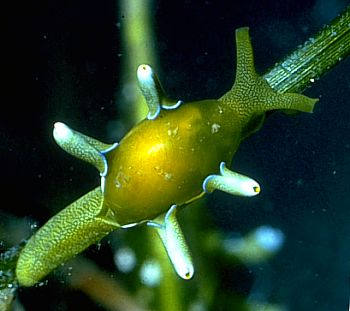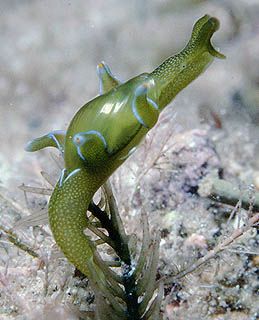

Roburnella wilsoni
(Tate, 1889)
Order: SACOGLOSSA
Superfamily: OXYNOOIDEA
Family: Oxynoidae
DISTRIBUTION
South temperate Australia from Bass St to southwestern Australia.
PHOTO
UPPER: American River, 3m, off boat ramp, E.Kangaroo Is, South Australia, 14 March 1978. Photo: R. Kuiter
LOWER: Point Turton Jetty, South Australia, 25 February 2001., 12 mm long. On Caulerpa brownii at 3.5m depth. Photo: John Chuk.
Only species in the genus Roburnella which is related to Oxynoe and Lobiger. As in those animals, R. wilsoni has a thin shell partly enclosed by parapodia. The edge of the parapodia bear two structures on each side, which are sometimes rolled into tubes, and sometimes unrolled into spoon-shaped lobes. It is associated with,and presumed to feed on the green algae Caulerpa brownii, Caulerpa scalpelliformis, and Caulerpa remotifolia.
Reference:
• Tate, R. (1889). Description of some new species of marine mollusca from South Australia and Victoria. Transactions of the Royal Society of South Australia, 11: 60-66.
Rudman, W.B., 2001 (June 28) Roburnella wilsoni (Tate, 1889). [In] Sea Slug Forum. Australian Museum, Sydney. Available from http://www.seaslugforum.net/find/robuwils
Related messages
Roburnella wilsoni from South Australia
June 30, 2001
From: John Chuk


Dear Bill,
Here are two photo's of Roburnella wilsoni taken on a night dive at Point Turton Jetty, South Australia, on 25 February 2001. The specimen is 12 mm in length and was found on the green alga Caulerpa brownii at 3.5m depth.
The species was abundant at this site but was only found at night and all specimens were found on C. brownii. The lower photo shows it from the underside, with the blue border to its foot.
Many thanks for all your recent help.
Best wishes,
John.
jchuk@giant.net.au
Chuk, J., 2001 (Jun 30) Roburnella wilsoni from South Australia. [Message in] Sea Slug Forum. Australian Museum, Sydney. Available from http://www.seaslugforum.net/find/4688Dear John,
Thanks for this wonderful little sacoglossan. I have never seen this species alive. It is considered to be a link between Oxynoe and Lobiger.
Best wishes,
Bill Rudman
